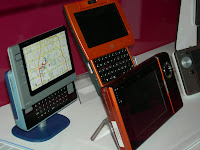I recently read an interesting
article about the impact of
switching costs on IT and consumer buyer behavior. Switching costs are the economic and non-economic costs of switching from one thing to its alternative. For example, the cancellation fee charged by mobile phone carriers are an economic cost to switching carriers before your contract has expired. This is clearly an effort by carriers to reduce their subscriber "churn". Alternatively, carriers will want to protect their investment in a subscriber's subsidized handset.
There are also a variety of non-economic switching costs which influence buyer behavior. For example, re-learning how to use a device can be a switching barrier. This is often cited by corporate IT departments in their delay to transition to new operating systems such as Windows Vista. Another non-economic switching cost is an investment in related infrastructure. For example, software written for Sun's Solaris operating system will not run under Microsoft Windows or IBM's
AIX operating system, stranding those hardware assets in a transition. Similarly, a consumer switching from standard definition
DVD's to
Blueray high definition
DVD's will not be able to play back a completing
HD-DVD format (except for some dual format schemes which been introduced).
In general, switching costs favor the incumbent player and are a barrier to entry for new players into the segment. For example, anyone with a large library of music purchased from
iTunes cannot play back this music on non-Apple MP3 players because Apple's
AAC digital rights management software is only found on
iPods. Other reasons why switching costs favor the incumbent include behavioral inertia, stranded assets, risk aversion, and lack of complementary products. So, any new product entering an established segment must demonstrate a clear and obvious user benefit in order to overcome these switching costs.
Many incumbent players use switching costs as a way of maintaining their market share (think of cable companies, etc). What happens in a world of zero switching costs? This trend is starting to happen in Internet software both in the enterprise space where "software as a service (
SaaS)" is an alternative to "shrink-wrapped" licensed software. A more immediate example is in on-line consumer services such as
YouTube,
MySpace, etc where subscribers have a choice of of competing on-line services. How do such services both retain their existing customers and gain new ones?
This is a new paradigm for marketing professionals to address.
 One of the ultra mobile PC's that I've been working on is a device designed to be used by children. This device, which was shown at the Intel Developer Forum in September 2006, has been ruggedized to withstand daily use by children carrying it in their backpacks to and from school.
One of the ultra mobile PC's that I've been working on is a device designed to be used by children. This device, which was shown at the Intel Developer Forum in September 2006, has been ruggedized to withstand daily use by children carrying it in their backpacks to and from school.










